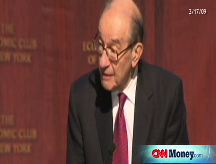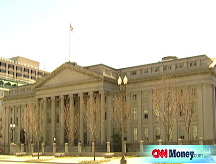Dawn of the dead banks
As big banks on government support continue to struggle, fears grow that some are becoming zombies like in Japan's lost decade. Is nationalization the cure?
NEW YORK (CNNMoney.com) -- They walk among us. And they're a heck of a lot scarier than anything George A. Romero ever imagined.
ZOMBIE BANKS!
The term refers to banks that continue to survive, but only because of government funding. In other words, they have not been sufficiently restructured to allow them to actually get healthy and contribute to economic growth. This was a problem during Japan's so-called "lost decade" in the 1990s.
Now some are worrying that big banks on TARP support such as Bank of America (BAC, Fortune 500) and Citigroup (C, Fortune 500), as well as smaller regional banks like Cincinnati-based Fifth Third (FITB, Fortune 500), are among the living dead.
"The use of the capital defines zombie status. When banks cannot use it for more than stabilizing their own condition, they are zombies. That's what you get when you give capital to insolvent institutions," said Joseph R. Mason, chaired professor of banking at Louisiana State University.
With this in mind, speculation that some banks may have to be nationalized, at least temporarily, has returned to the markets.
In an interview in the Financial Times Wednesday, former Federal Reserve chairman Alan Greenspan said that nationalization may be necessary "in order to facilitate a swift and orderly restructuring" of banks, adding that doing so would "allow the government to transfer toxic assets to a bad bank without the problem of how to price them."
But Mason doesn't think that an outright government takeover of banks would be effective. He argues that the government should not be in the business of running a bank so it can restore it to health.
Instead, the government should take over the most troubled banks in order to sell them off, essentially what the FDIC already does with failed banks.
"Seizure of a bank may not be nationalization. When regulators come in, they should not create a big government bank to actively compete with private banks. It should be to liquidate assets. That's what needs to happen," Mason said.
Along those lines, Mason said there are three classes of banks right now.
The zombies are "hopelessly insolvent" banks that can't be fixed with more infusions of capital. Instead, they need to be taken over. He places Citi and BofA in this category.
The banks in Mason's middle tier are ones that are reeling but not yet down and out. So more financial aid could be helpful. He said former investment banks Morgan Stanley (MS, Fortune 500) and Goldman Sachs (GS, Fortune 500) are in this group.
Finally, there are solvent banks that Mason thinks could use government funding to buy up the assets of the zombies. He said regional bank PNC (PNC, Fortune 500), which already acquired National City, and JPMorgan Chase (JPM, Fortune 500) are in this class.
Mason argues that it could take as long as a decade for the government to completely liquidate a big bank. So a conservator would have to manage a sort of bridge bank to keep normal day-to-day operations going. But the ultimate goal would be an orderly liquidation.
Not everyone agrees that liquidation is the best way to fix the banking system though.
"The goal of nationalization should be to save systemically critical banks. If it's not systemically critical, then Sheila Bair already has the tools to deal with it," said Daniel Alpert, managing director of investment bank Westwood Capital, referring to the chairman of the FDIC.
Alpert argues that a better way to nationalize banks would be for the government to buy a majority interest in the common stock in the banks with the biggest problems.
While that would wipe out existing shareholders, Alpert said it would be the strongest way for the government to show that it simply won't allow big banks to go belly up.
Following the investment, Alpert said the government could set up a board of trustees, kind of a group of regulatory wise men, to force out management and corporate boards and start the process of nursing the big banks to health.
So which solution makes more sense? Nationalize to liquidate the ailing banks or nationalize to cure them?
One expert on Japan's lost decade said a marriage of these two strategies might be what could work best.
Hugh Patrick, a professor and director of the Center on Japanese Economy and Business at Columbia Business School, said there clearly needs to be more regulatory oversight of the most troubled banks. He said Japan took too long to truly take control of problem banks.
In some cases, the government may want to provide financing for stronger banks to take over weaker ones. "I wouldn't be surprised to see, either under forced circumstances or voluntarily, more consolidation in the banking sector," said Patrick.
But the only real way to fix the banking system, Patrick said, is to learn from Japan's mistakes and do what Alpert is suggesting, i.e. act more aggressively.
"If the U.S. nationalizes banks, it should be to clean up a particular institution, get its balance sheet straight and get rid of management," Patrick said. "The ultimate goal is to clean up banks enough so that private investors would be willing to invest capital in them. That is similar to what eventually happened in Japan."
After all, as any fan of most zombie movies knows, you don't kill a zombie by giving it more meat. It takes a fatal blow to the head. ![]()




